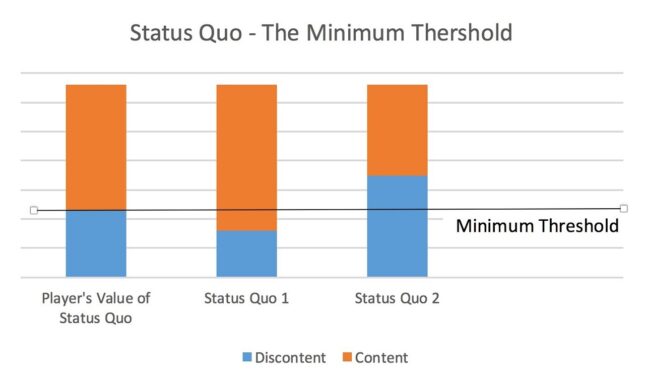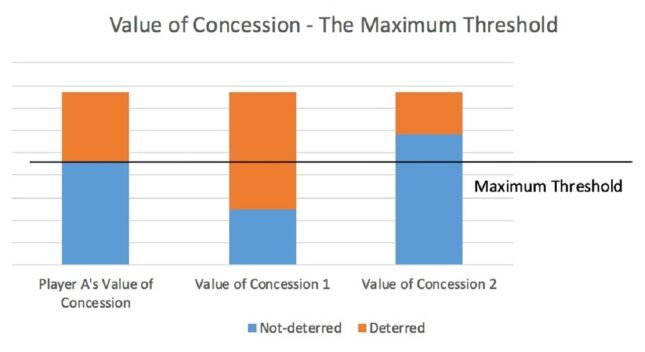US-DPRK Talks: A Victory for Peace, A Tie between Titans, or Just Half-time?
This article is a summary of my essay for the course ‘International Politics’. Writing essays has definitely been the highlight of the International Studies programme for me, as it allows me to a) develop independent research skills and b) go in-depth on topics I’m personally interested in.
The announcement that North Korea was willing to suspend its missile tests made headlines across the world. Among many other topics, it has put the following question back on the table: does nuclear deterrence work? Why did the U.S.’ possession of nuclear weapons not dissuade North Korea from proliferating its own nuclear arsenal?
Today, I will employ game theory to test the efficacy of the U.S. nuclear deterrent. The theory I will use is called ‘Perfect-Deterrence Theory’. It is slightly different from mainstream deterrence theory, but here is what you need to know.
How does Perfect-Deterrence Theory work?
The game works in nodes. Each node is an instance of decision. Players have two options: either they defy (D) or concede (C). The game is made of 3 nodes, the third and last node always leads either to ‘capitulation’ or ‘conflict’.
Now that you know the structure, here are the actors and variables which determine the interactions between actors. There are two types of players: soft and hard players. And there are 4 key variables to the game. Here’s an overview:
Types of Players
1. Soft players prefer capitulation to conflict.
2. Hard players prefer conflict to capitulation.
Four Key variables
1. Capability refers to an actor’s military capacity.
2. Credibility is an actor’s perceived willingness to use its deterrent threat.
3. The value of the status quo refers to a player’s attitude toward the structure of the international order. It works like a threshold. This value determines the point below which a player will see the benefits of conflict as outweighing the risks of conflict. It is referred to as the minimum threshold. Below, in Status Quo 1 the player content and likely to remain compliant. In Status Quo 2, the player is discontent and likely to challenge the Status Quo.

4. The value of concession is the minimum amount of demands that must be satisfied for a player to be deterred. In other words, once player A is content with its value of concession, any increase in player’s B capacity will only be a waste of resources as it will no longer impact player A’s sense of deterrence. It’s a bit like pouring water into a full cup. Hence, its denomination: maximum threshold.

How do these variables work in practice?
Now that we have the theory behind us, let’s illustrate how this works through the example of Imperial Japan.
Imperial Japan was discontent with the status quo as it desired to possess colonies of its own. Furthermore, Imperial Japan’s value of concession was very high i.e. it would not want to concede if conflict – and even loss – were the most probable outcome. Imperial Japan was, therefore, a hard player. Its capabilities were vastly inferior to the U.S., yet it nevertheless launched its attack against Pearl Harbor.
According to Perfect Deterrence Theory (PDT), this is how we can interpret history. The U.S. had a capable threat. However, it had low or intermediate levels of credibility. Moreover, Japan’s high value of concession, as well as its dissatisfaction with the status quo, meant that Japan perceived that launching an attack could bring more benefits than costs.
How does PDT apply to the US-DPRK tensions?
We will have to map out the interaction in three separate stages. Firstly, I will determine the value of each variable for the U.S. and DPRK respectively. Secondly, I will simulate the game by describing what happens on each node. Finally, I will interpret the results in light of what is the main question I’m trying to answer: do nuclear deterrents actually deter?
Stage 1: Defining Variables
Capability?
- The U.S has a highly capable threat. In 2016 U.S. defense spending exceeded $600 billion. However, one must note that this capability is rather strategic than operational in nature, as the U.S. currently lacks a ready nuclear stockpile that could be deployed against North Korea.
- DPRK also has a capable threat. This definition is sustained by U.S. security assessments and estimates of North Korea’s military budget also suggest, as well, as the North Korean regime’s acquisition of nuclear capabilities.
Credibility? (Remember, we’re using the word in its technical sense!)
- The U.S. has a low to intermediate credibility. The heated rhetoric adopted by Donald Trump can be interpreted as means of increasing each country’s credibility. However, this rhetoric came against the backdrop of Obama’s “strategic patience” which contributed to a decreased level of credibility.
- The DPRK has high levels of credibility. Its strategy has remained constant and predictable for the past decade and a half, and it sets explicit goals. For instance, the Supreme People’s Assembly passed a law explicitly stating that “nuclear weapons of the DPRK are just means for defense (…) [to deter] the U.S. and [its] nuclear threat”.
What’s our conclusion? A PDT analysis identifies ambiguous levels of credibility – especially from the U.S. side – as the determining variable in deterrence between North Korea and the U.S.
But wait, where are the other two variables? For the sake of briefness, I chose not to include them. I’ll explain why below!
Stage 2: The Game
What’s interesting in this game analysis is that the nuclear standoff between both countries can be modeled in two ways. One can either assume that North Korea was the challenger (CH) and U.S. the Defender (DF), or vice-versa. However – as I will show below – the implications for nuclear deterrence are very similar no matter what perspective we adopt.
Remember I left two variables out? Here’s why. This initial assumption also influences the value of the status quo. Because by altering the definition of the CH/DF, we also change the actors’ relation to the status quo. And the value of concession? It is still unclear what the minimum demands of each side are, for which reason we better just reframe from speculating.
Now, let’s simulate the game!
Scenario 1 considers North Korea’s decision to pursue nuclear proliferation the initial defiant act, node 1. In response – node 2 – the U.S. imposed sanctions, deployed the Terminal High Altitude Area Defense (THAAD) and exacerbated its rhetoric (Lu 2017). Thus, if North Korea agrees to hold talks it will have chosen C in node 3, and avoided conflict.
Scenario 2 considers the U.S. assertive stance shaping the international order as the defiant instigator, node 1. North Korea retaliates with nuclear proliferation – node 2 – and the U.S. decision to resume talks is interpreted as a choice to concede, node 3. Scenario 2 elucidates how the U.S. nuclear arsenal was ineffective in dissuading North Korea’s nuclear proliferation.
Stage 3: Interpreting the Results
The game simulation found that altering the definition of Challenger and Defender does not alter the results of the game. In fact, the two different assumptions (scenario 1 and 2) provide the same conclusion from different perspectives: The U.S. nuclear deterrent failed. Grounded on the assumption that North Korea was the challenger (scenario 1), the game simulation shows that the U.S. nuclear deterrent not only failed in preventing North Korean nuclear proliferation, it legitimated it. The contrary perspective (scenario 2) highlights that, despite adequate capability, deterrence failed due to the U.S.’ lack of credibility. Thus, the findings suggest that nuclear arsenal not only inherently lacks credibility, but it also instigates vertical proliferation.
What does this mean for the US-DPRK summit?
Just before I get to the conclusion, let me acknowledge two points. First, game-theory is a troublesome approach. It is binary, it is reductive, it oversimplifies, not to mention that I did not include the mathematical element of this simulation. Second, my interpretation of the results was very meager. If you want a more extensive interpretation, I will be glad to send you the complete essay on this topic.
Nevertheless, I think this approach can be elucidating in some aspects. First, it casts doubts on the efficacy of nuclear deterrents. We live in a world on the glimpse of two disasters: climate change and nuclear war. The second one is rarely discussed. So, any effort to put it in the agenda is beneficial. Second, this analysis gives us a perspective into what is likely to determine the outcome of the talks on June 12th: the value of concession.
North Korea has pledged to denuclearize. But what does this actually mean? Is it denuclearization in the same sense that the U.S, Russia, China etc. are committed to denuclearization? (i.e. in the long distant future…) Or is the Trump administration going to demand a complete, verifiable, irreversible denuclearization?
Let’s hope June 12th provides some answers on whether these talks mean a victory, a tie, or the start to the second-half of the game.
As I said in my introductory note, the International Studies (IS) programme gives students an excellent opportunity to students by allowing us to devise our own essays. The biggest contribution the programme has given me is to develop critical thinking, as well as the ability to deconstruct assumptions and theories. If you combine this skill with personal motivation and discipline, your chances to excel in your field of interest are set!

